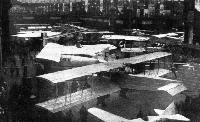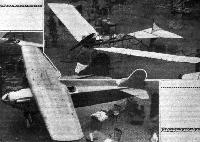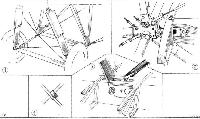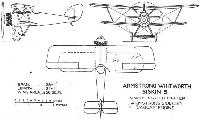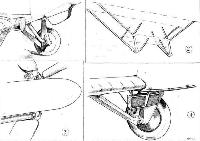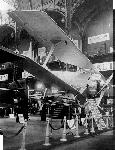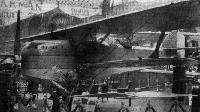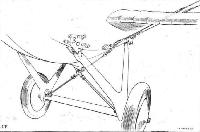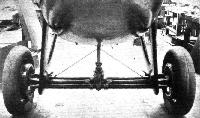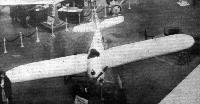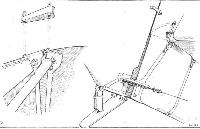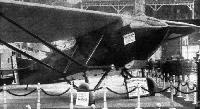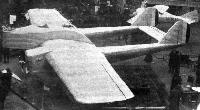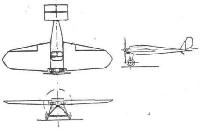Фотографии
-
The Breguet XIX made famous by Lieut. Peletier d'Oisy's flight to China. With exception of the wing covering, and that of the rear portion of the fuselage, this machine is built entirely of metal.
Самолёты на фотографии: Breguet Br.19 - Франция - 1922
-
THE NINTH INTERNATIONAL AERO EXHIBITION, PARIS: General view of the Grand Palais, showing the striking scheme of decoration (carried out in yellow and blue), which combines beauty with utility. In the view (looking north) will be seen the S.I.M.B., Latecoere, Capt. D'Oisy's Breguet, etc.
Самолёты на фотографии: Bernard Bernard V - Франция - 1924Breguet Br.19 - Франция - 1922Latecoere L.15 - Франция - 1924Latecoere L.16 - Франция - 1923
-
DUTCH MILESTONES AT THE PARIS SHOW: Alongside with the latest Fokker D XIII biplane - which is fitted with a Napier "Lion" engine - is exhibited the little wire-braced monoplane built and flown by Mr. Fokker in 1911. As will be seen above, Mr. Fokker believed in tubular metal construction even in those days.
Самолёты на фотографии: Fokker D.XIII - Нидерланды - 1924Fokker Spinne - Германия - 1910
-
A BRITISH AEROPLANE AT THE PARIS AERO SHOW: A three-quarter front view of the Armstrong-Whitworth "Siskin 5" - a single-seater fighter fitted with an Armstrong-Siddeley "Jaguar."
Самолёты на фотографии: Armstrong Whitworth Siskin - Великобритания - 1921
-
Another view, front, of the Armstrong-Whitworth "Siskin 5."
Самолёты на фотографии: Armstrong Whitworth Siskin - Великобритания - 1921
-
THE ONE AND ONLY BRITISH AEROPLANE AT THE PARIS AERO SHOW: A skeleton view of the Armstrong-Whitworth "Siskin 5" (Siddeley "Jaguar"). British aircraft construction is well represented and well displayed in this exhibit.
Самолёты на фотографии: Armstrong Whitworth Siskin - Великобритания - 1921
-
THE NINTH INTERNATIONAL AERO EXHIBITION, PARIS: General view of the Grand Palais, showing the striking scheme of decoration (carried out in yellow and blue), which combines beauty with utility. In the view (looking south) will be discerned the Armstrong-Whitworth "Siskin," F.B.A. flying boat, etc.
Самолёты на фотографии: Armstrong Whitworth Siskin - Великобритания - 1921FBA Type 19 / 21 - Франция - 1924
-
THE ARMSTRONG-WHITWORTH "SISKIN 5": A side view of the only British aeroplane exhibited at the Paris Aero Show.
Самолёты на фотографии: Armstrong Whitworth Siskin - Великобритания - 1921
-
ON THE ARMSTRONG-SIDDELEY "SISKIN": 1. General view of the undercarriage, which is of the oleo type, with long wheel travel. 2. Attachment of lower rear spar to fuselage longeron. The fuselage joint shown is typical of the construction employed. 3. The inter-plane struts go to fittings on the neutral axis of the wing spars, so that no twisting stresses are caused by the pronounced stagger. Inset, 4, shows the very neat wirelocking device.
Самолёты на фотографии: Armstrong Whitworth Siskin - Великобритания - 1921
-
Armstrong Whitworth Siskin 5. Single Seater Fighter Armstrong Siddeley "Jaguar" Engine
Самолёты на фотографии: Armstrong Whitworth Siskin - Великобритания - 1921
-
SOME FOKKER DETAILS: 1. View of the centre portion of the lower plane, showing fittings for attaching it to the fuselage. 2. One of the retractable radiators which are a feature of this machine.
Самолёты на фотографии: Fokker D.XIII - Нидерланды - 1924
-
The Latecoere Lat. 17 is a small single-engined cabin machine of 300 h.p. carrying four passengers at a speed of 120 m.p.h., and is intended for use on the France-Morocco route.
Самолёты на фотографии: Latecoere L.14 / L.17 - Франция - 1924
-
ON THE DEWOITINE STAND: On the left is seen a D1C1, which had to land in a thick fog and turned over without sustaining other damage than a bent rudder and one or two punctures in the wing covering. In the background is the large commercial monoplane, while on the right is a single-seater fighter similar to the D1C1 except for the cabane, which is slightly different in construction.
Самолёты на фотографии: Dewoitine D.1 / D.9 - Франция - 1922Dewoitine D.14 - Франция - 1924
-
Two more Dewoitines: In the foreground the light monoplane with 6-cylinder Vaslin engine, and behind it the D.1 single-seater fighter all-metal monoplane with 300 h.p. Hispano-Suiza.
Самолёты на фотографии: Dewoitine D.1 / D.9 - Франция - 1922Dewoitine D.7 - Франция - 1923
-
AT THE PARIS AERO SHOW: The S.I.M.B. racing monoplane. In this machine the new-type Lamblin radiators are mounted beneath the cantilever wings.
Самолёты на фотографии: Bernard Bernard V - Франция - 1924
-
THE S.I.M.B. RACING MONOPLANE: 1. View of the undercarriage, Lamblin wing radiators, neat engine exhausts, etc. 2. Three-quarter front view from above. This sketch gives an excellent idea of the clean lines of the machine. Note the air intakes facing forward. 3. The tail skid, which is partly faired in, and an elevator hinge.
Самолёты на фотографии: Bernard Bernard V - Франция - 1924
-
The Bleriot-Spad type 51 single-seater fighter, French-built "Jupiter" engine, is armed with four machine-guns. This machine is claimed to be the world's best climber.
Самолёты на фотографии: Bleriot-SPAD S.51 - Франция - 1924
-
AT THE PARIS AERO SHOW: The'twin-engined C.A.M.S.33B flying boat (Hispano-Suiza engines), designed and constructed by Chantiers Aero-Maritimes de la Seine.
Самолёты на фотографии: CAMS CAMS 33 - Франция - 1923
-
A MODERN FAIREY SEAPLANE: A side view of the Fairey "Pintail" Mark IV two-seater fighter seaplane, fitted with a Napier "Lion" engine.
Самолёты на фотографии: Fairey Pintail / Fawn - Великобритания - 1920
-
FARMANS AT THE PARIS AERO SHOW: The large twin-engined (400 h.p. Lorraine) "Jabiru" commercial "semi-sesquiplan." Note the pilot's elevated position. It was this type of machine which won the last two Grand Prix competitions for commercial aeroplanes.
Самолёты на фотографии: Farman F.120 / F.3X / F.4X Jabiru - Франция - 1923
-
SOME FARMAN DETAILS: 2. Diagrammatic perspective sketch of the system of bracing employed in the two Farman sesquiplans. 3. Wing strut attachments and undercarriage hinge on the Farman "Jabiru." 4. One side of the "Jabiru "undercarriage. Note the radiator position and the locking rod of the engine cowling.
Самолёты на фотографии: Farman F.120 / F.3X / F.4X Jabiru - Франция - 1923
-
WITH A BRISTOL JUPITER IN MESOPOTAMIA: We show above a "Nighthawk" Fighter fitted with a 400 h.p. Bristol "Jupiter" which successfully completed a test of 100 hours in Mesopotamia under trying. tropical conditions. This is the same type of engine that is exhibited at the Paris Aero Show.
Самолёты на фотографии: Gloster Mars (Bamel) / Nighthawk / Sparrowhawk - Великобритания - 1921
-
Характерными отличиями прототипа истребителя Hanriot H.31 являлись фюзеляж, установленный между крыльями бипланной коробки, и индивидуальные обтекатели головок цилиндров.
ON THE HANRIOT STAND: The biplane single-seater fighter with Salmson engine.Самолёты на фотографии: Hanriot H.31 - Франция - 1925
-
Регистрационный номер: H-NADD One of the novelties of the Paris Aero Show: Model of the Koolhoven three-engined commercial sesquiplan. Two of the three Siddeley "Puma" engines are mounted on the short lower plane stumps and drive tractor air-screws, while the third engine, driving a propeller, is mounted on the top plane above the fuselage.
Самолёты на фотографии: Koolhoven FK-33 - Нидерланды - 1925
-
ANOTHER DUTCH EXHIBITOR AT THE PARIS SHOW: The F.K.31 two-seater fighter monoplane exhibited by the Nationale Vliegtuigindustrie, of which Mr. Frederick Koolhoven is technical director. Note the wide chassis, which is reminiscent of the B.A.T. machines.
Самолёты на фотографии: Koolhoven FK-31 - Нидерланды - 1922
-
ON THE KOOLHOVEN F.K.31: 1. View, looking upwards, of the pilot's cockpit, circular opening in wing, and aileron crank. 2. Side doors give access to the cockpits of the F.K31, a very neat locking device, shown in 3, securing the doors during flight. The oleo undercarriage has a travel of 10 ins.
Самолёты на фотографии: Koolhoven FK-31 - Нидерланды - 1922
-
The twin-engined Latecoere, Lat.15, has its engines placed close to the fuselage, and although this reduces the turning moment when one engine is stopped, it seems likely that the resistance of three streamline bodies placed so close together is somewhat high.
Самолёты на фотографии: Latecoere L.15 - Франция - 1924
-
The Pierre Levasseur two-seater fighter has a "droppable" undercarriage and Vee bottom so as to enable it to alight on the sea.
Самолёты на фотографии: Levasseur PL.5 / PL.9 - Франция - 1924
-
The undercarriage of the Pierre Levasseur can be dropped by releasing the lateral bracing wires. When the lever in the centre of the wires is pulled over to starboard the wire attachments slip out of their slots, and the struts fall out of the forked fittings.
Самолёты на фотографии: Levasseur PL.5 / PL.9 - Франция - 1924
-
The Paris Aero Show: The all-metal front unit of the Nieuport-Delage sesquiplan, consisting of the wing spars and the engine and pilot's section of the fuselage. The rear portion of the fuselage (which is of monocoque construction), as seen on the left, is attached as a second unit to complete the machine.
Самолёты на фотографии: Nieuport-Delage Ni-D-42 / Ni-D-62 - Франция - 1924
-
An Adjustable Airscrew at the Paris Aero Show: A close-up view of the Nieuport-Delage adjustable-pitch airscrew.
Самолёты на фотографии: Nieuport-Delage Ni-D-42 / Ni-D-62 - Франция - 1924
-
Three-quarter rear view of the Nieuport-Delage 42 C.2 sesquiplan, showing undercarriage and wing bracing arrangement. Lamblin radiators are fitted underneath the small lower planes.
Самолёты на фотографии: Nieuport-Delage Ni-D-42 / Ni-D-62 - Франция - 1924
-
The Nieuport-Delage adjustable pitch airscrew is made from steel tubes of large diameter, cut in such a way as to provide the required taper in chord and change in angle of attack. Our sketches show how the two halves are joined together and locked by boss and front plate.
Самолёты на фотографии: Nieuport-Delage Ni-D-42 / Ni-D-62 - Франция - 1924
-
Регистрационный номер: G-EBKA Самолёты на фотографии: Short Stellite / Cockle / S.1 - Великобритания - 1924
-
Transmission and differential of the Tampier T.3, which can be driven along a road or street en automobile.
Самолёты на фотографии: Tampier T.1 - T.4 - Франция - 1921
-
Front view of the Tampier T.4, which has folding wings. A two-cylinder starting engine is fitted.
Самолёты на фотографии: Tampier T.1 - T.4 - Франция - 1921
-
This photograph does not show the grand staircase, but illustrates the large cabin exhibited on the Caudron stand. This machine has flown from Paris to Moscow.
Самолёты на фотографии: Caudron C.61 / C.81 / C.183 - Франция - 1921
-
The S.E.C.M. all-metal night-bomber, type 12 B.N.2, is shown in skeleton. The metal construction is very pretty, but one doubts whether some of the complicated joints are really necessary.
Самолёты на фотографии: SECM (Amiot) SECM 10 / 12 BN2 - Франция - 1921
-
SOME DEWOITINE DETAILS: On the left is shown the manner in which the famous French designer solves the problem of a detachable cantilever tail plane spar, and on the right the nose of the Dewoitine light monoplane, with six-cylinder Vaslin water-cooled engine. The cowling over the engine has been omitted. Note the nose radiator.
Самолёты на фотографии: Dewoitine D.7 - Франция - 1923
-
The prettiest machine in the Show: The Pander light monoplane, with Y-type Anzani.
Самолёты на фотографии: Holland (VIH) H.2 - Нидерланды - 1924
-
ON THE PANDER LIGHT MONOPLANE: On the right the sprung tail skid, which is mounted on, and moves with, the rudder. On the left the attachment of the rear chassis strut and rear spar U-bolt. Straps run down the sides of the monocoque fuselage so as to distribute the loads.
Самолёты на фотографии: Holland (VIH) H.2 - Нидерланды - 1924
-
FOREIGN INTEREST IN THE MARTINSYDE A.D.C.1: The photograph was taken on the occasion of a demonstration of the successful and latest production of the Aircraft Disposal Co at Waddon. The group reading from left to right, includes Maj. J. Stewart (Sales Manager of the A.D.C.), Col..M. O. Darby (Managing Director), Capt. T. Toyoda (Japanese Naval Attache), Capt. Cortijo (Spanish Royal Naval Commission), Lieut.-Comdr. Kato (Imperial Japanese Navy), and Capt. Square (Spanish representative of the A.D.C.).
Самолёты на фотографии: Martinsyde A.D.C.1 / Nimbus - Великобритания - 1924
-
The Latecoere monoplane, Lat.16, is a single-engined machine with high performance, designed for the France-Africa lines.
Самолёты на фотографии: Latecoere L.16 - Франция - 1923
-
Latecoere "Lat-16" 400 hp Lorraine-Dietrich Engine
Самолёты на фотографии: Latecoere L.16 - Франция - 1923
-
Super-streamlining at the Paris Aero Show: The 500 h.p. Farman fighter, a sesquiplan in which streamlining has been carried out to a high degree.
Самолёты на фотографии: Farman F.160 - Франция - 1924
-
SOME FARMAN DETAILS: 1. General view of the undercarriage of the single-engined reconnaissance machine. Note the headlights in the leading edge, and the Lamblin radiator under the fuselage. 2. Diagrammatic perspective sketch of the system of bracing employed in the two Farman sesquiplans.
Самолёты на фотографии: Farman F.160 - Франция - 1924
-
THE ALL-METAL SCHNEIDER TWIN-FUSELAGE MONOPLANE: This machine, built of a new aluminium alloy produced by the famous Creusot firm under the name "Alferium," carries an armament of six machine-guns.
Самолёты на фотографии: Schneider Sch.10M - Франция - 1925
-
THE ALL-METAL SCHNEIDER TWIN-FUSELAGE TWIN-ENGINED MONOPLANE: The sketch on the right shows one of the engine nacelle-undercarriage fuselages. The petrol tank is mounted aft of the engine and landing gear, so that in case of puncture by machine-gun fire the petrol is drained out without danger of setting the machine on fire. On the left is shown the corrugated wing covering and the manner of its attachment at leading and trailing edges.
Самолёты на фотографии: Schneider Sch.10M - Франция - 1925
-
Самолёты на фотографии: Dixie monoplane - США - 1924
-
ON THE HANRIOT STAND: A general view of the stand, showing the monoplane in the foreground.
Самолёты на фотографии: Hanriot H.34 / H.35 - Франция - 1924
Статьи
- Flight

